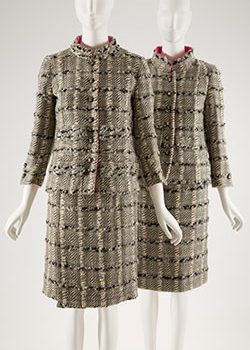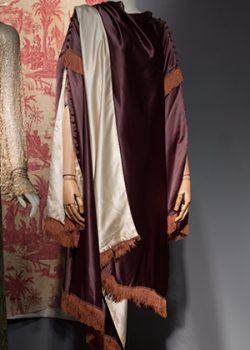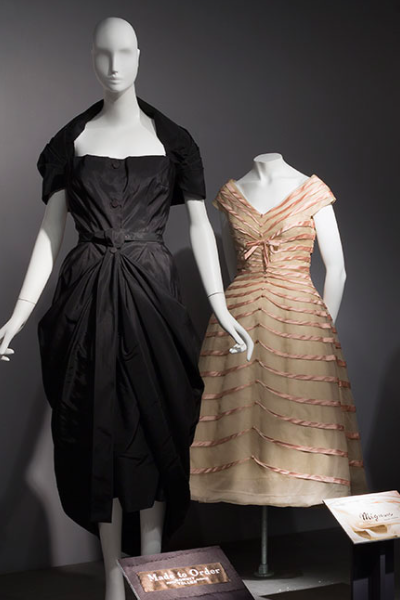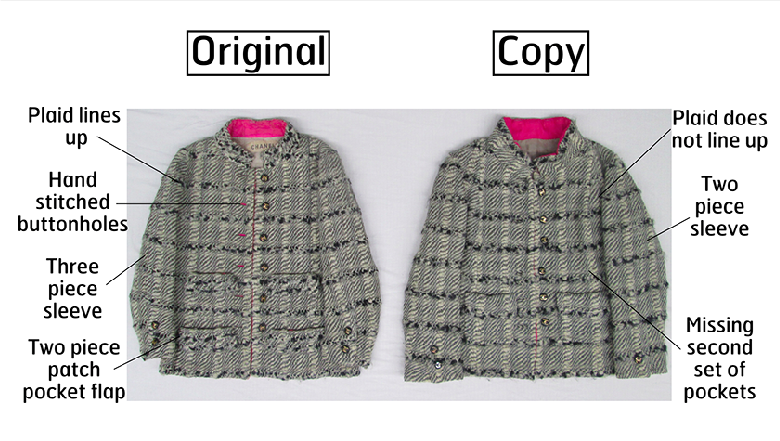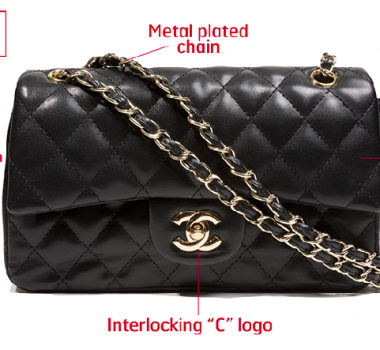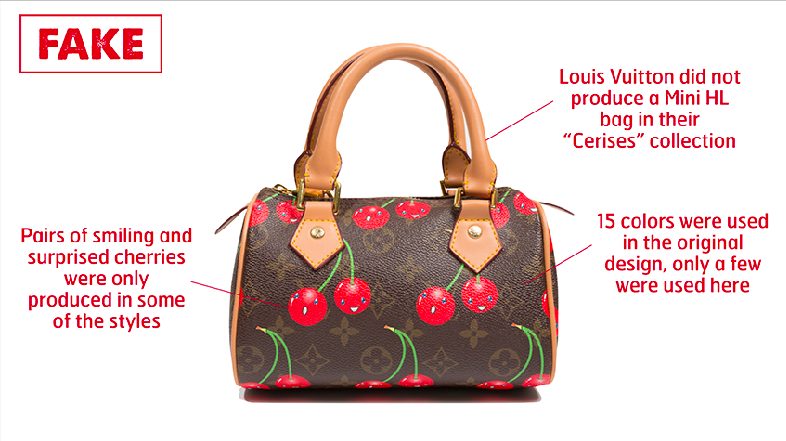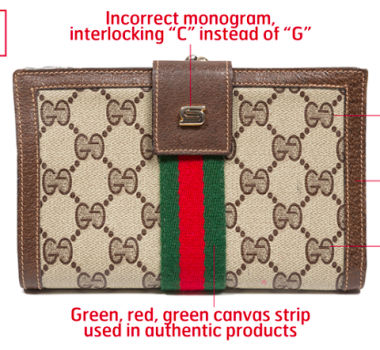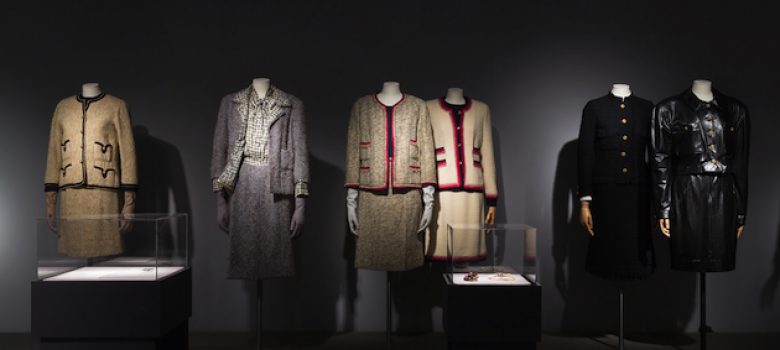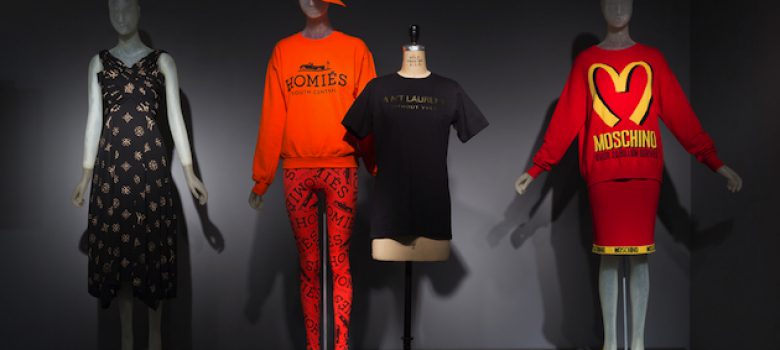――アリエル・エリアさんは今回、FIT美術館で「Faking It」展を企画されました。同展覧会は、ファッション分野における「偽物」の問題を主題に据えた展示です。「偽物」と謳ってはいますが、無許可で製造された偽造品だけでなくライセンス製品、あるいはオマージュやパロディといった問題にまで視野を広げている点が特徴的です。「Faking It」展の企画は、どのような関心から構想を練っていったのでしょうか?
今回の展覧会の構想はいくつかのアイデアから着想を得ています。まず、私がファッションの歴史を研究するようになって以来、コピーと偽造品の生産という問題は長年の関心事項でした。そうした興味を最も駆り立てたのは、クチュール・ハウスが彼らのデザインのコピーを、ライセンスとして百貨店に販売するというシステムの存在です。こうした実践から、違法コピーのすべての体系が生じたと言えます。現在のファッションを取り巻く環境に話を移せば、ファストファッション企業がいかにして告訴されることなく、インディペンデントなデザイナーたちのデザインを盗用することが可能であるのかという点が私の関心事にはなります。また、こうした問題は、アメリカ国内における知的財産とデザイナーたちのクリエイティブな作品が持つ権利の欠如といった話題へと転じるのです。
偽造品の問題に関して言えば、ニューヨークのキャナル・ストリートで偽造品を買う観光客の姿は、私にとっては日々見慣れた光景になっていますが、誰がどのような条件下でそうした鞄などを作っていて、それに対してラグジュアリー・ブランドは違法産業にどのような対策を講じているのかなど、産業全体を見渡すと同時に、探求してみたいという思いがありました。
・中央: ポール・ポワレのイブニング・コート(正規複製品, 1917仏) ©2015 The Museum at FIT
・右: クリスチャン・ディオールのライセンスコピー製品(両方とも1955米) ©2015 The Museum at FIT
――展覧会の発表後、一般の人々からはどのような反響がありましたか? 具体的な事例も含めてお答えいただければと思います。
今回の展覧会はとても好意的な反応を得ることが出来ました。来場者の多くが展示された内容には相関関係があるとも言っていました。一般の方々の大半はH&MやZARAの顧客であり、模造品を購入したことがあります。そこで私は、彼らに馴染みあるトピックを提供し、そうした産業にまつわる歴史と複雑さを知ってもらいたいと考えていました。結果として、多くの来場者から偽造品と模造品に関して新しい学びがあったと言ってもらえました。館内ツアーを開催していた時期には、クチュール・ハウスが百貨店とライセンス契約を結び、複製、販売をすることを許可していることを知り、驚く人もいました。また、来場者のほとんどは、もしシャネルが未だにこうした方法を行っていたら、ライセンス販売されるシャネル・スーツのコピーを買えるのではと関心を寄せていました。偽造品に関して言えば、一般の人々は「偽造品が製造される環境がいかに劣悪であるかは知る由もない」と口々に言っていました。
――現在、アメリカでもファッションにおける知的財産を保護しようという運動があります。
アメリカ国内におけるファッション産業において、現在、デザイナーの知的財産に対する意見は分裂しています。2012年には「Innovative Design Protection Act」(IDPA、デザイン保護法)が提出されましたが、残念なことに議会から承認されませんでした。多くのデザイナーや企業は、ファッション・デザインを3年間保護できるようにすることで得られる利益を確信している一方で、それに反対する議論がなされています。業界内での合意がなされていない現状から、議会においても法案の議論を進めることが困難となっているのです。
・右: クリスチャン・ルブタンのオリジナル製品と偽造品の比較 ©2015 The Museum at FIT
――あなた自身はファッションにおける知的財産についてはどのようにお考えですか? また、展覧会の開催以前と以後で心境の変化はありましたか?
多くの専門家と知的財産に関する話を交えた後に、私はある結論に達しました。展覧会を開催する前に、私自身のきちんとした意見を持っていたいという思いもありました。そうすれば来場者の方たちとそれを議論することもできるので。
私はファッション・デザイナーを保護する必要があると考えています。フランス、イタリア、イギリス、そしてカナダのファッション業界は高い水準の知的財産保護を行っており、企業は成長を続けています。若いデザイナーを守るための法律を制定することは大切です。1シーズンのコレクションを作るためには多くの時間と資金が費やされますが、彼らがそれを店頭へと売り出す前に、ファストファッションのブランドがいとも容易くコピー商品を販売してしまいます。ファストファッションという巨大企業は、それが若い才能にどれほどの影響を与えるかを考えることなくデザインを盗んでしまうのです。おそらく、有効な解決策はファストファッションのブランドにデザインを参考にすることを認めつつも、1シーズン経った後に、デザインのコピー販売を認めるといったことでしょう。
――日本の読者へメッセージと共に、展覧会の紹介をお願いします。
今回の展覧会はファッションにおけるコピーの公認と非公認の歴史を探求するものです。偽造品から成る非公認のコピーに多くの人々が慣れ親しむ一方で、彼らはライセンス化されたクチュール・デザインの例を取っても、公認されたコピーに関しては馴染みがありません。今回の展覧会を通じて、コピーの曖昧な部分に光を当てるとともに、公認から非公認にまでおよぶ様々なレベルの複製品の存在を知ってもらいたいと思いました。例えば、様々な形態でのクチュールのドレスの再現は、再生産されたものはどれほどホンモノであるのか、素材、縫製、あるいは技術、何に裏付けられているのかという疑問を呈するものです。
「Faking It」展: FAKING IT – Originals, Copies and Counterfeits
・場所: ニューヨーク州立ファッション工科大学美術館(The Museum at FIT)
・開催期間: 2014年12月2日〜2015年4月25日
・Webページ: http://exhibitions.fitnyc.edu/faking-it/
ニューヨーク州立ファッション工科大学美術館アシスタント・キュレーター。
Assistant Curator of Costume and Textiles
ニューヨーク州立ファッション工科大学美術館(The Museum at FIT):
http://www.fitnyc.edu/museum/
原文
―― What kind of social problem made you to make this exhibition’s plan? And how did you promoted to the audience?
There were a few ideas that inspired the idea for the exhibition. I had been curious about copying and knockoffs since beginning to study the history of fashion. What peaked my curiosity was the system of couture houses selling licensed copies of their designs to department stores. From this practice emerged an entire system of illegal copying. Moving into the present state of fashion, I became interested in how fast fashion companies were able to copy the work of independent designers without being sued. This brought me to the topic of intellectual property and the lack of rights designers had regarding their creative work in the United States. On the topic of counterfeits, I was familiar with the practice of tourists purchasing counterfeits on Canal street in New York, but I wanted to look further into this industry and explore who were making these bags, under what conditions, and how were the luxury brands responding to this illegal industry.
―― After launched this exhibition, how have the public respond you? Please answer with some example.
The public responded positively to the exhibition. Many visitors said the content was relatable. A majority of the public has shopped at an H & M or Zara and has purchased a counterfeit. I wanted to present the public with a familiar topic and then educate them on the history and complexities involved in those industries. Many attendees left saying they learned something new about knockoffs and counterfeits. While giving tour of the exhibition, visitors were surprised to learn that couture houses allowed departments stores to purchase licensed copies of their designs to reproduce and sell. Everyone was curious if Chanel still participated in this practice, because they wanted to purchase a licensed copy of a Chanel suit. In regards to counterfeits, a majority of the public said, “I had no clue how bad the working conditions are that counterfeit products are made under.”
―― In the U.S. also have a movement about protecting intellectual property of Fashion nowadays, so how do they think of it?
The industries opinion regarding the protection of the intellectual property of fashion designers is split in the U.S. In 2012 the Innovative Design Protection Act (IDPA) was proposed. Unfortunately, it was not passed by congress. While many of the designers and fashion industry saw the benefit of protecting a fashion design for three years, other argued against it. Because there is not a consensus within the industry it is difficult for Congress to move forward on a bill that cannot be agreed upon in the fashion industry.
―― Continuing the question, how do you think of intellectual property of Fashion by yourself? Did it make you change your opinion before and after launched?
After speaking with a number of professionals on the topic I came to a conclusion on the subject. I wanted to have a decided opinion on the topic before the exhibition opened, so I could discuss it with people visiting. I think there does need to be some form of protection for fashion designers. Other established fashion industries in France, Italy, Britain, and Canada have high levels of intellectual property protection and their industries continue to thrive! It is important to implement a legislation to protect the young designers. Too many designers time and money into creating a collection, just to have it immediately knocked off by a fast fashion company before the designer can put it in their store. Fast fashion giants steal designs without thinking of how it affects emerging talent. A good solution might be to allow fast fashion companies to reference a design, but not create a carbon copying of the design or to allow a fast fashion company to copy the design after it has been on the market for a season.
―― Last question from us, please give Japanese reader the message and some introduction about this exhibition.
The exhibition explores the history of authorized and unauthorized copying throughout fashion history. While many people are familiar with unauthorized copying, consisting of counterfeiting many are not as familiar with authorized copy, in reference to the practice of licensed copies of couture designs. Throughout the exhibition I wanted to present the various levels of copying ranging from authorized to unauthorized, while shedding light on the grey areas of copying as well. For example the various levels of creating an authorized copy of a couture dress can call into question how authentic is the reproduction? Is it using the same materials, sewing techniques,ect.
FAKING IT – Originals, Copies and Counterfeits
The Museum at FIT Fashion & Textile History Gallery
December 2, 2014 – April 25, 2015
http://exhibitions.fitnyc.edu/faking-it/

